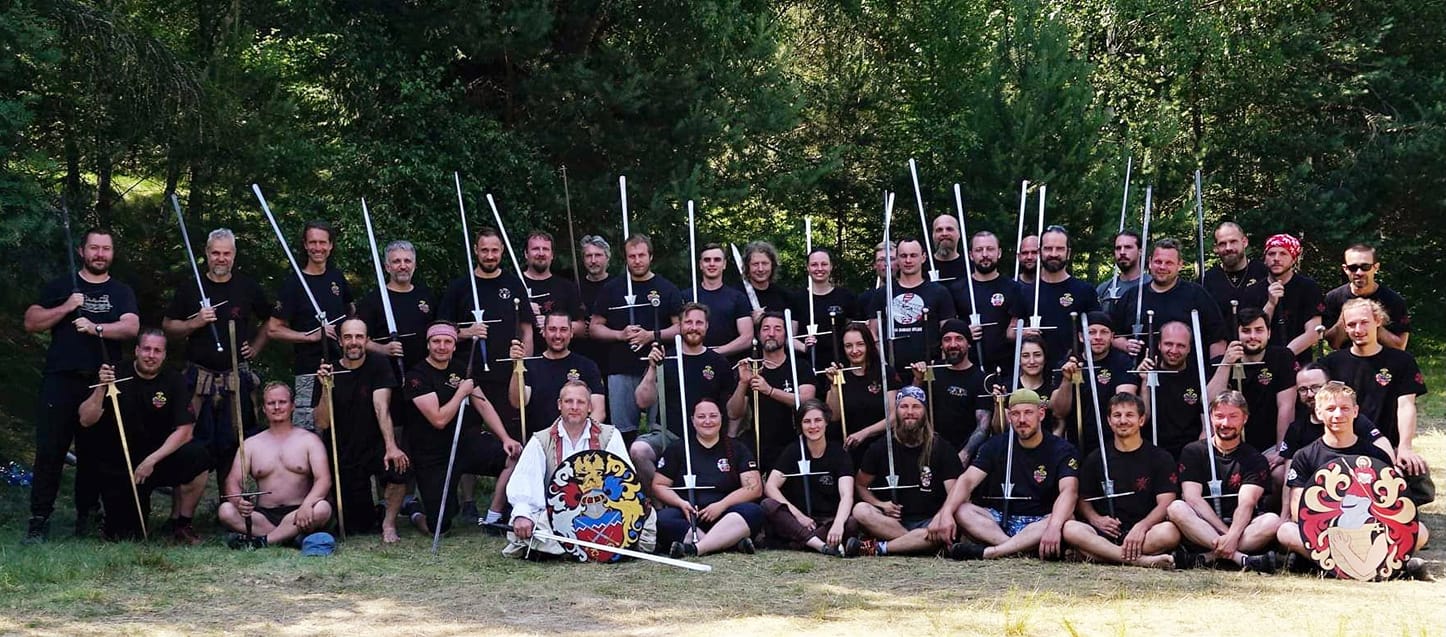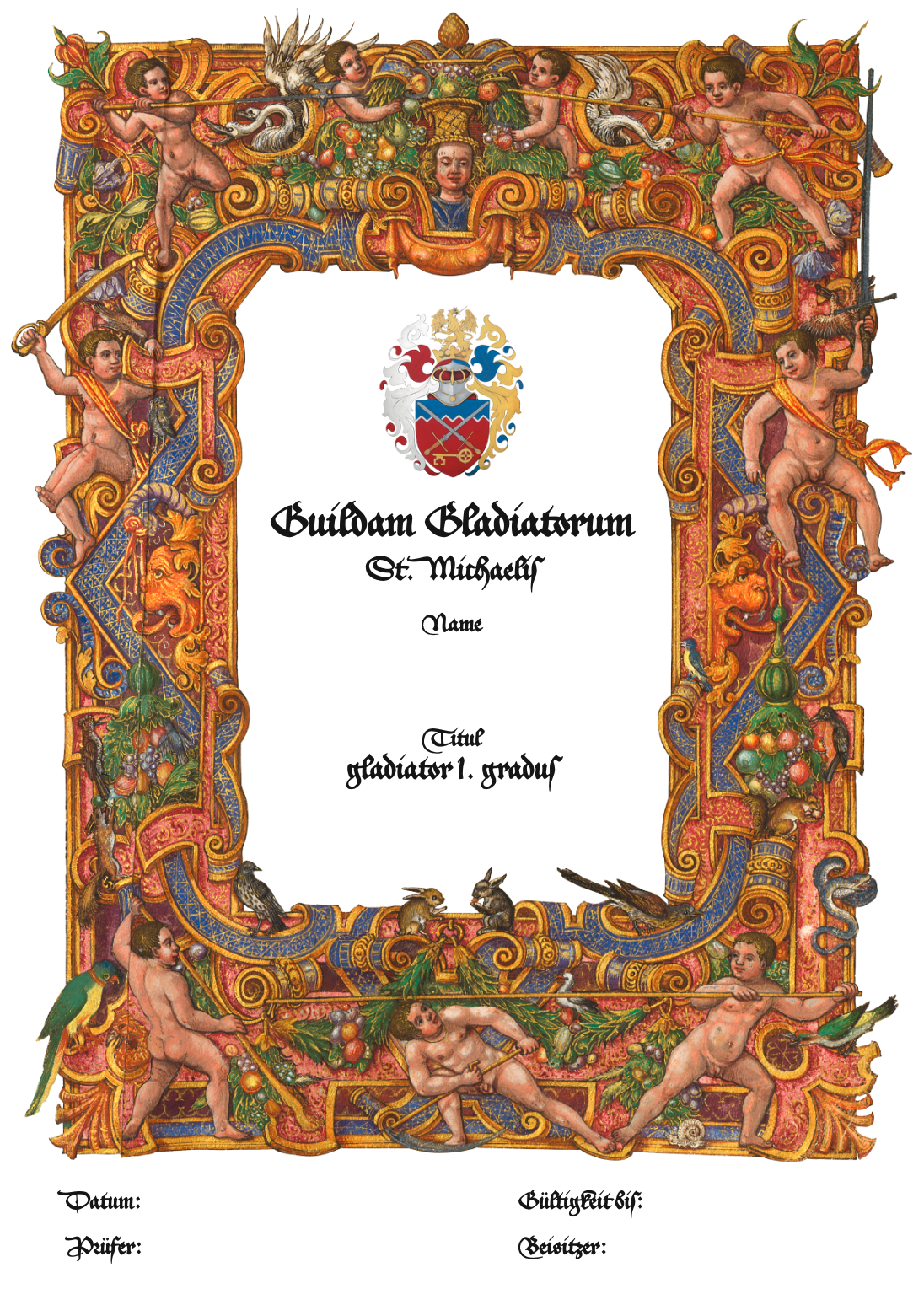About our Fencing school
Navigation:
Our story


Our schools:
Fencing school
- The aim of the training is the safe performance of Blossfechten / free fencing without protective equipment conducted in such a way as to avoid injury.
- In combat, one tries to hit the other in the head between the ears in a safe and controlled manner.
- It is not allowed to effectively stab the face or otherwise work the tip of the sword dangerously.
- The tip of the sword may be used safely in order to force the opponent to react (for example, in the initial phase by shooting off the tip - Ortschiessen), but not in the immediate vicinity of the face area.
- Except attacks on the hands and palms up to the wrists (these are not allowed), the opponent can be hit everywhere so that a noticeable hit does not cause injury.
- Intensity and energy of strikes must be conducted to the extent acceptable to the opponent.
- Both opponents shall be struck in a tolerable and safe manner.
- Strikes to exposed bones such as elbows, collarbones, etc. should be avoided. As these are very fragile and it is easy to break them.
- We choose targets to force the opponent to accept defeat.
- The number of hits does not matter if they are in a sequence that leads to the end of the encounter by the opponent surrendering.
- The fight continues until one is unwilling or unable to continue.
- Above all of the above is the overriding imperative of consideration and friendship, which is the crown of chivalry and art.
- Any rude or inconsiderate action, any lack of control over blows, leads to the immediate end of the combat.
- Only people with a positive relationship and mutual respect can fence together. The goal is mutual enrichment and improvement of skills.
- All are each other's teachers and friends.
The three apprentice levels called “Fencer“-“Fechter“
Fencer 1st degree:
Animals – selection of development moves, movement in eight directions, balance, oblique movement, fencing
steps, Alber, Langort, Up. Fencing module, three circles, leading the sword, applying to the body to four
openings, four main positions and from these Langort against the upper strike - Oberhaw.
Fencer 2nd degree:
Langort against the Oberhaw from all positions. All steps, breaking the strikes by long edge, Ablauffen -
Running off, nachreissen, zombies – pair sword play
3rd degree fencer
All cuts and strikes, breaking of all strikes along all parts of the blade, advanced zombies
Three journeyman levels ending with Vorfechter
Younger journeyman: works freely at the pace of nach and indes, learns Handarbeit selection.
Older journeyman: works in tempo Vor Nach and Indes (Before, After and Indes). He can start from all positions.
Vorfechter: prepares and assists with teaching. Works in all three times - tempos, knows how to use all elements of the system, prepares and helps with teaching.
Master status
Masters represent the school. They are free to perform the art and true to the style of their master. They form an unbroken lineage that enriches and refines the teaching.They are the bearers of the knightly art and tradition. The master is expected to perform and represent the fencing guild and his school at the highest level. Kindness, restraint, skill and lecturing talent. A master is first and foremost a teacher and mentor.
The three levels of master
Junior Master: Submagister: Master of a specific Weapon Category. Master grades will be specified for one or more weapons. Sub-master of the Dussack, Sword, etc.
Master – Fechtmeister: The exam follows the traditional structure to successfully pass selected number of fights with either three weapons: Longsword, Dussack, Stangelin or the seven knightly weapons: Dagger, Longsword, Dussack, Rapier, Stangelin, Staff and Hallebard. The master must fight in front of the committee against selected opponents.
Rada mistrů volí velmistra
Frei Fechter – Svobodný šermířský mistr/ starší mistr – mistrovská zkouška ze sedmi rytířských zbraní: Dýka, Tesák, Dlouhý meč, Rapír, Hůlka, Hůl, Halapartna. Dvanáct soubojů s každou.
Grandmaster – Grossmeister: The Council of Masters elects the Grand Master. This is a top level serving more organizational role.
Order of the Fencing Guild of St. Michael the Archangel
First
The name of the guild and its public form is: Guildam Gladiatorum Santci Michaelis, the Fencer's Guild, the fencing guild of Saint Michael the Archangel, Guildam Gladiatorum.
Second
The leaders and responsible persons of the guild leadership are: the captains and masters of the longsword and all the weapons of chivalry and the Ringen. Certified martial arts instructors according to the legal standard of the country where the guild masters operate.
Founders and Masters
- Peter Turya
- Martin Pulchart
Masters
- Vojtěch Messer Vacek
- Ondřej Drtil
- Jan Zmelík
- Maximilian Powik
- Florian Gruber
- Ralf Gutzeit
- Robin Vogelei
Third
General and legal form - The Fencing Guild is a fencing community founded in 2010 in CR. As of 2017, the Guild is a limited liability company Guildam Gladiatorum Ltd. In addition to the parent company based in CR, the Guild consists of commercial and non-profit associations and clubs.
- Drei Klingen - Augsburg Germany
- Klopffechters Erben - Bremen Germany
- Stahltragger Wesseling Germany
- Fencersguild Malchen Germany
- Fencersguild Stade Germany
- Fencersguild Tostedt Germany
- Fencersguild Riga - Latvia
- Fencersguild Usti nad Labem CR
- Fencersguild Křivoklát CR
- Fencersguild Mohelnice CR
- Fencersguild Prague Red Hill CR
- Ringen Club Prague CR
- Barrandov School of Fencing CR
- Fencersguild Guild Fencing School Litovel CR
- Fencersguild Karlovy vary CR
- Fencersguild Rokycany CR
- Fencersguild Turnieres-Chemnitz/Gütersloh/Halle Germany
- Fencers guild Brasil - Paty do Alferes; Chief instructor: Andre L.M.Roland
Fourthly
Activity - the guild teaches the art of chivalry according to preserved written sources from the 14th to 17th centuries. It carries out research and publication activities. It organises public instruction in the form of fencing and wrestling schools and tournaments. It produces and sells replicas of historical weapons for educational and collecting purposes.
Fifthly
The structure of the guild - the guild is organized according to the original model of the fencing fraternity of the Federfechters and Markus. The leadership of the guild consists of the founders and masters. For the top leadership there are always two, a governor and a provost. Each school or troop determines who will lead and represent it in the leadership.
Sixth
Membership - Anyone who is interested in becoming a member becomes a member if they pass: the guild test of the 1st degree of any weapon or match. Takes the sword oath and joins the active membership database at fencersguild.com.
For the seventh time.
School and Troop Membership - The following are the requirements for being granted guild school or troop status: the leader must be a guild member. He must have the permission and blessing of his teacher to teach his chosen weapons. He must have an approved three or five year plan for his club. An approved selection of weapons. Approved the extent to which the weapons will be taught. Defined technical levels of their school. Approved name and legal form of his school in his country. If all conditions are met, the Masters Council will issue a Guild decret for the period of time specified for that school. The first year of the school is probationary. If it proves its worth, it receives a giclée for three years. In the case of existing schools that do not change their scope and activities, the gild is automatically renewed. Participation in international guild meetings at least once a year is a condition of active membership. If the school representative fails to attend, the status of the guild school is suspended until he or she does. The Council of Masters then grants or does not grant renewal of guild school status depending on the level and situation.
Eighth
Customs and manners of the Fencing Guild The Guild teaches the virtues and manners of chivalry, which are part of the art of chivalry. Following the pattern of the teachings in the original texts and the European tradition, we are concerned with a harmonious concept of everyday life in accordance with chivalric values.
Ninth
- The Guild/Knightly Code
- Faith
- The Truth
- Love
- Courage
- Kindness
- Mercy
- Humility
Tenth
Rules of general conduct:
Lying, stealing, damaging other people's property, unreasonably hurting others, bringing the school or guild
into disrepute, excessive use of alcohol or addictive substances, and failure to practice good hygiene are
considered serious violations of the rules and may result in termination of guild membership.
Eleventh
Certification - The issuance of certificates and glees is twofold. The first is issued by the Guild for instructors and schools. The second is certification at the level of the schools themselves. Each school determines for itself how it will certify in accordance with the Guild's curriculum. The number of levels, the form and the content of the message are determined by the school. The above follows from and is consistent with the presented three to five year program of the school on the basis of which the school was admitted to guild status.
Twelfthly
Logos and guild symbols - may only be used by guild schools in agreement with the guild leadership. Each design must be approved by the guild leadership. This applies to: the guild griffin, the griffin in a circle. Both objects with and without inscription. Inscriptions: Guildam Gladiatorum, Fencer's guild.
Thirteenth
Honorary Membership - a public tribute on behalf of the Guild, awarded for contribution and merit in the field of martial arts research and action. Honorary Membership confers no guild privileges.
- Ladislav Petráš
- Václav Soudek
- Kevin Maurer
- Leonid Krizek
- Peter Koza
- Petr Monster Prince
- Karel Dolezal
Fourteenth
Rights and Duties of Instructors - Guild Instructors are required to follow the Guild Methodology, which is based on the instructions of the original written sources. Guild leadership grants a healthy degree of benevolence in how to teach, but with zero tolerance for defined outcomes. It is not permissible to change the original terminology and the form of positions and performances that belong to it. Specific guild-defined procedures must be maintained as presented and delivered by the teacher. They are obliged to pass them on unchanged. In general, teachers have the freedom to teach fixed material according to themselves. Students must achieve the same results regardless of the method of teaching. The content and form must be kept in line with the original sources and the guild concept.
The teacher/instructor is obliged to present the students with the legal minimum regarding safe conduct during training at the place of instruction.











